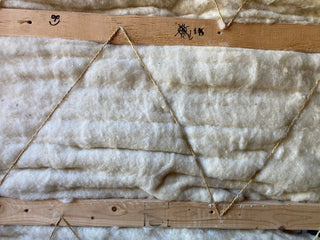In the insulation world, we all get caught up on R-Value, despite its shortcomings (of which we’ve written before). Another thermal performance measure worth attention is U-Value, a close cousin to R-Value but with some key differences.
A Quick Review
R-Value is the main metric used to judge a thermal insulation layer’s performance. The higher the R-value, the better the product’s insulating ability. Total R-Value for insulation is calculated by simply multiplying the R-Value per inch by the thickness of that layer of insulation :
5.5 inches of Havelock Wool Blown insulation with an R-Value per inch of 4.3 has a Total R-Value of 23.7 (5.5 x 4.3 = 23.7)
This R-Value of 23.7 is what many would claim as your Wall Assembly R-Value. But it doesn’t tell the whole story. For that, we’d want to think about the Total R-Value of a Wall Assembly and U-Value.
Your Whole Wall
Total R-Value of your wall includes ALL layers of the assembly, not just insulation. Additional layers can include exterior masonry. For example:
Layer #1: A 12-in-thick CMU with an R-Value per inch of 0.14. Total R-Value of 1.7 (12 x 1.4 = 1.7)
Layer #2: 5.5 inches of Havelock Wool Insulation with an R-Value per inch of 4.3. Total R-Value of 23.7 (5.5 x 4.3 = 23.7)
These two layers provide an R-Value of 25.4 (1.7 + 23.7 = 25.4)
Going one step further
Another layer often ignored is the air film that naturally exists on both sides of the wall. This small amount of stagnant air actually has some thermal resistance. For R-Value calculations we can use 0.23 for the exterior air film and 0.74 for the interior.
Continuing on with our example…
R = 25.4 + 0.23 +0.74 = 26.4 Total R-Value

With this more realistic measure of R-Value, we can now calculate U-Value, also known as thermal transmittance. This describes the actual heat flow through your whole wall. U-Value is simply the reciprocal sum of the wall’s Total R-Value.
U = 1 / 26.4 = 0.0378
The lower the U Value the lower the thermal transmittance. Yes, it’s related to the R-Value of insulation but in this example, it incorporates more of the actual wall assembly.
Quite often we hear the claim that simply increasing the thickness of insulation will lead to a commensurate improvement in thermal performance. Using the example above, we can show that doubling the insulation in your wall does not double your wall’s overall thermal performance. Here is the same wall with 2x the R-Value plus the interior and exterior air films
R = 50.8 (2x the R-Value) + 0.74 + 0.23 = 51.8 for a U-Value of 0.0193
It’s a great improvement in thermal transmittance but it is not 2x better than our original U-Value of 0.0378.





